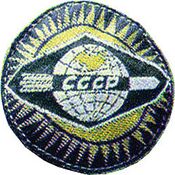Engineering:Soyuz 9
 Andriyan Nikolayev and Vitaly Sevastyanov on the 1971 commemorative stamp "424 Hours On Earth's Orbit" of Soviet Union | |
| Mission type | Test flight |
|---|---|
| Operator | Soviet space program |
| COSPAR ID | 1970-041A |
| SATCAT no. | 04407 |
| Mission duration | 17 days, 16 hours, 58 minutes, 55 seconds |
| Orbits completed | 288 |
| Spacecraft properties | |
| Spacecraft | Soyuz 7K-OK No.17[1] |
| Spacecraft type | Soyuz 7K-OK |
| Manufacturer | Experimental Design Bureau (OKB-1) |
| Launch mass | 6460 kg [2] |
| Landing mass | 1200 kg |
| Crew | |
| Crew size | 2 |
| Members | Andriyan Nikolayev Vitaly Sevastyanov |
| Callsign | Сокол (Sokol – "Falcon") |
| Start of mission | |
| Launch date | 1 June 1970, 19:00:00 GMT |
| Rocket | Soyuz |
| Launch site | Baikonur, Site 31/6[3] |
| End of mission | |
| Landing date | 19 June 1970, 11:58:55 GMT |
| Landing site | Steppes in Kazakhstan |
| Orbital parameters | |
| Reference system | Geocentric orbit[4] |
| Regime | Low Earth orbit |
| Perigee altitude | 207.0 km |
| Apogee altitude | 220.0 km |
| Inclination | 51.70° |
| Period | 88.59 minutes |
 Vimpel Diamond for entrainment patch | |
Soyuz 9 (Russian: Союз 9, Union 9) was a June, 1970, Soviet crewed space flight. The two-man crew of Andriyan Nikolayev and Vitaly Sevastyanov broke the five-year-old space endurance record held by Gemini 7, with their nearly 18-day flight. The mission paved the way for the Salyut space station missions, investigating the effects of long-term weightlessness on crew, and evaluating the work that the cosmonauts could do in orbit, individually and as a team. It was also the last flight of the first-generation Soyuz 7K-OK spacecraft, as well as the first crewed space launch to be conducted at night. In 1970, Soyuz 9 marks the longest crewed flight by a solo spacecraft.
Crew
| Position[5] | Cosmonaut | |
|---|---|---|
| Commander | Second and last spaceflight | |
| Flight Engineer | First spaceflight | |
Backup crew
| Position | Cosmonaut | |
|---|---|---|
| Commander | ||
| Flight Engineer | ||
Reserve crew
| Position | Cosmonaut | |
|---|---|---|
| Commander | ||
| Flight Engineer | ||
Mission
The flight tested, for a longer period of time than any other, the capacity of the hardware and the human crew, on the long-term exposure to space conditions and observing (both visually and photographically) geological and geographical objects, weather formations, water surfaces, and snow and ice covers. The crew conducted observations of celestial bodies and practiced astronavigation, by locking onto Vega or Canopus, and then used a sextant to measure its relation to the Earth horizon. The orbital elements were refined to three decimal places by the crew.[2]
Commander Nikolayev and flight engineer Sevastyanov spent 18 days in space conducting various physiological and biomedical experiments on themselves, but also investigating the social implications of prolonged spaceflight. The cosmonauts spent time in two-way TV links with their families, watched matches in the 1970 FIFA World Cup, played chess with ground control, and voted in a Soviet election. The mission set a new space endurance record and marked a shift in emphasis away from spacefarers merely being able to exist in space for the duration of a long mission (such as the Apollo flights to the Moon) to being able to live in space. The mission took an unexpected physical toll on the cosmonauts; in order to conserve attitude control gas during the lengthy stay in orbit, Soyuz 9 was placed in a spin-stabilisation mode that made Nikolayev and Sevastyanov dizzy and space sick.[6]
Mission parameters
- Mass: 6,460 kg (14,240 lb) [2]
- Perigee: 207.0 km (128.6 mi) [4]
- Apogee: 220.0 km (136.7 mi)
- Inclination: 51.70°
- Period: 88.59 minutes
Chess game
Script error: No such module "Chessboard".
During the mission, the two cosmonauts played a game of chess against a pair of opponents on Earth: head of cosmonauts Nikolai Kamanin and fellow cosmonaut Viktor Gorbatko. It was the first documented game played by humans while in space.[7][lower-alpha 1] It was a consultation game, with the two cosmonauts playing as White and jointly deciding each move, while the two players on Earth did likewise as Black. The set used aboard Soyuz 9 had pegs and grooves to keep the pieces in place and did not include magnets, which might have interfered with the spacecraft's systems.[8]
The game began as a Queen's Gambit Accepted, with both players castling kingside. Material was exchanged evenly throughout the game. Toward the end of the game White checked Black four times, and rapid exchange of remaining pieces ensued. At 35. Qxf6+, Black responded with the final move 35... Kg8 (the only legal move), moving the king to the flight square g8. In the final position each side had a queen and five pawns, with no passed pawns. The game concluded as a draw.
Sevastyanov was a chess enthusiast. Following Soyuz 9, he served as president of the Soviet Chess Federation from 1977-1986 and 1988-1989.[8]
Return
The spacecraft soft landed in the steppes of Kazakhstan, and the crew was picked up immediately. Adjusting to gravity of Earth seemed to present a minor problem for the two cosmonauts.[2] They required help exiting the descent module and were virtually unable to walk for a few days.[6] Nonetheless, this experience proved the importance of providing crews with exercise equipment during missions. After landing the crew spent 2 weeks in a quarantine unit originally designed for cosmonauts returning from Moon landings.[6] At the time the Soviet press reported that this was done to protect the cosmonauts in case space travel had weakened their immune systems. However, the quarantine process was likely practice for the Soviet crewed lunar program, which at that point had not been abandoned.[6]
See also
Notes
- ↑ Although the Soyuz 9 game is the first documented chess game played in space, some sources have indicated that this was not the first time a chess set was flown in space. During Expo 2020 in Dubai, a chess set was exhibited which was said to have been flown aboard Soyuz 3 and Soyuz 4.[8] (Dubai hosted the 2021 World Chess Championship concurrently with Expo 2020). However, it is unclear whether the set was used on either mission. Soyuz 3 had a single crew member, and was a failed docking attempt with the uncrewed Soyuz 2. Soyuz 4 also launched with a single crew member aboard, but quickly returned to Earth with another two cosmonauts. The latter had launched aboard Soyuz 5 and carried out the first-ever crew transfer via EVA, boarding Soyuz 4 for return to Earth.
References
- ↑ Soyuz-9 embarks on a record-breaking mission www.russianspaceweb.com, accessed 27 December 2022
- ↑ 2.0 2.1 2.2 2.3 "Display: Soyuz 9 1970-041A". NASA. 14 May 2020. https://nssdc.gsfc.nasa.gov/nmc/spacecraft/display.action?id=1970-041A.
 This article incorporates text from this source, which is in the public domain.
This article incorporates text from this source, which is in the public domain.
- ↑ "Baikonur LC31". Encyclopedia Astronautica. http://www.astronautix.com/sites/bairlc31.htm.
- ↑ 4.0 4.1 "Trajectory: Soyuz 9 1970-041A". NASA. 14 May 2020. https://nssdc.gsfc.nasa.gov/nmc/spacecraft/displayTrajectory.action?id=1970-041A.
 This article incorporates text from this source, which is in the public domain.
This article incorporates text from this source, which is in the public domain.
- ↑ Mir Hardware Heritage – 1.7.3 (wikisource)
- ↑ 6.0 6.1 6.2 6.3 Harvey, Brian (2007). Soviet and Russian Lunar Exploration. Springer-Praxis. pp. 179–181. ISBN 978-0387218960.
- ↑ 7.0 7.1 Fox, Mike; James, Richard (1993). The Even More Complete Chess Addict. Faber and Faber. p. 97. ISBN 9780571170401.
- ↑ 8.0 8.1 8.2 "Chess in outer space". FIDE. 13 April 2020. https://www.fide.com/news/482.
- ↑ Schipkov, Boris. "Space (Soyuz-9) - Earth (Control Center) [D20, Radio Match 1970"]. http://www.chessib.com/spacearth70.html?i=1.
- ↑ "Soyuz 9 Cosmonauts vs. Ground Control". https://www.chessgames.com/perl/chessgame?gid=1259395.


